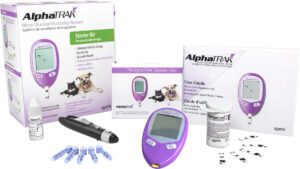Picture it: You have just returned home from a dinner party to find that your dog has urinated on the kitchen floor – again. She has always been a good dog about going outside to do her business. Why is she suddenly leaving large puddles of urine in the house? Increased urination is one of the telltale signs of diabetes. Could your dog be battling canine diabetes mellitus? Maybe. The incidence of diabetes in dogs is on the rise, according to the North American Veterinary Community.
Symptoms of diabetes in dogs include:
- Increased urination
- Unusual peeing accidents in the house
- Drinking large amounts of water
- Urinating more often and in large amounts
- Changes in appetite (eating more or less)
- Weight loss despite good appetite
- Cloudy eyes/development of cataracts
- Increased infections, including urinary tract and skin
How Diabetes Is Diagnosed in Dogs
Diabetes is defined as persistent hyperglycelmia (high blood glucose) and glucouria (glucose in the urine). If your dog is exhibiting signs of diabetes, your veterinarian will want to run blood tests (including a complete blood count and a chemistry panel) and collect a sterile urine sample for a urinalysis.
The chemistry panel for a dog with diabetes will show elevated blood glucose and sometimes will also show elevated cholesterol, triglycerides, and liver enzymes. The urinalysis will show glucose in the urine but may also reveal the presence of protein, ketones, and bacteria. Many dogs with diabetes mellitus have a concurrent urinary tract infection (UTI), so a urine culture and sensitivity will be recommended to confirm the presence of bacteria and determine the correct antibiotic for treating the UTI.
What Causes Diabetes in Dogs?
In dogs, diabetes is almost always caused by a decreased production of insulin. Insulin is produced by special cells in the pancreas called beta cells. When beta cells either produce less insulin or are destroyed by an episode of pancreatitis or an immune-mediated disease, the result is diabetes mellitus.

There are some conditions in which diabetes is caused by insulin resistance. In these circumstances, the dog’s beta cells are still producing insulin, but his or her body has a decreased capacity to utilize it.
Intact female dogs who are either pregnant or between heat cycles are at an increased risk of developing transient diabetes.
Dogs who are obese or are receiving certain chronic medications (such as steroids, progestins, and cyclosporine) are at risk for developing insulin-resistant diabetes.
Dogs who have a concurrent endocrine disorder, such as hyperadrenocorticism (also known as Cushing’s disease) or hypothyroidism, are also at risk for diabetes development.
Certain breeds of dogs are known to be more likely to develop diabetes mellitus during their lifetime. These breeds include Australian Terriers, Beagles, Samoyeds, and Keeshonden.
Treatment for a dog with diabetes
The mainstay of diabetes treatment in a dog is insulin therapy. Long-acting insulin is injected under the skin twice a day. The needle and syringe used to administer insulin are small. Dogs hardly even notice the injection, especially if they are being distracted by food or a treat! Your veterinary team will give you a demonstration on how to give insulin and will help you become comfortable with this process.

There are three different types of insulin that are used to treat canine diabetes. Two of these insulin types are approved by the U.S. Food & Drug Administration (FDA) for use in dogs while one of them is not (but is still commonly used).
Both Vetsulin and ProZinc are FDA-approved insulins for use in dogs. Vetsulin is given twice a day and is available in two forms – vial and pen form. With the vial form, you draw up the appropriate dose in an insulin syringe and inject the insulin into your dog. With the pen form, you select the appropriate dose on the pen, insert the needle under your dog’s skin, and press the button to inject the insulin. People who have difficulty reading the numbers on a syringe or who feel uncomfortable with handling syringes may have an easier time with the Vetsulin pen.
ProZinc is given either once or twice a day depending on your dog’s response to the insulin. This insulin is only available in the vial form. Therefore, it requires the use of an insulin syringe to draw up and inject the insulin. Both ProZinc and the vial form of Vetsulin require U-40 size insulin syringes – this is different than what is used by humans with diabetes, who require U-100 size insulin syringes.
Novolin N and Humulin N are insulins used to treat diabetes mellitus in people. They are not FDA-approved for use in dogs but have been used “off label” for many years to treat diabetes in canines.
Options for insulin for dogs used to be limited and expensive. Vetsulin was approved by the FDA in 2013 and ProZinc was approved for use in dogs in 2019. Novolin and Humulin were also very inexpensive compared to the products approved for dogs. Fortunately, now both Vetsulin and ProZinc are typically less expensive than Novolin and Humulin. Vetsulin and ProZinc also last longer and function better in the canine body than Novolin and Humulin.
Diet for Dog Diabetics
Diet plays an important role in managing diabetes in dogs. Dogs who are overweight should be started on a weight-loss plan. It’s important not to lose weight too quickly and to weigh your dog once or twice a month to ensure weight loss is occurring at an appropriate rate. Your veterinarian may recommend a prescription weight-loss diet that is high in fiber to help achieve weight loss and better daily control of blood sugar.
Dogs who are at an ideal body weight or are underweight may also benefit from a diet that is high in both soluble and insoluble fiber. In certain circumstances, the addition of high-fiber vegetables (such as canned pumpkin or green beans) or fiber supplements (such as psyllium) may be beneficial. Talk to your veterinarian before instituting any diet change or adding any supplements.
There is no way to treat diabetic dogs without insulin. But there are two classes of medications that may help to improve glycemic control (daily control of blood sugar) in diabetic dogs. Acarbose works by inhibiting the absorption of glucose by the small intestine. This medication may be recommended in dogs for whom insulin therapy alone is not enough to control their high blood sugar.
Medications in the incretin class of drugs (such as Byetta, Bydureon, and Victoza) are hormones that work primarily by stimulating insulin secretion from the pancreas. These medications can only be used in conjunction with insulin. They are not substitutes for insulin therapy.
Monitoring a Diabetic Dog
The goals of treating a diabetic dog are to resolve the symptoms of increased thirst, urination, and appetite; to keep the blood glucose from becoming too low (hypoglycemia); and to keep the blood glucose below the level at which glucose enters the urine. This is different than the goals of treating a diabetic person, in which tight control of blood sugar is achieved through frequent monitoring of blood glucose and daily adjustments to the insulin dose.
There are several methods for monitoring diabetic dogs to ensure appropriate management. Your veterinarian will likely recommend a blood glucose curve be performed in their hospital, especially after the initial diagnosis. This is to ensure that your dog is not developing hypoglycemia (low blood sugar) when starting insulin therapy. A properly completed blood glucose curve will help determine the correct dose of insulin for your dog.
During a blood glucose curve, a very small sample of blood is obtained every two hours to measure the dog’s blood glucose. The blood glucose values are charted over a 12-hour period to see how your dog responds to his or her current insulin dose.
A blood glucose curve should be completed after starting insulin therapy and seven to 14 days after changing the dose of insulin. Then it should be completed at least once every three months to ensure your dog’s diabetes remains well-controlled. It should also be done when symptoms of diabetes return in a previously well-controlled diabetic or when hypoglycemia is suspected.
For dogs who are stressed by the idea of spending a day at the veterinary hospital, completing a blood glucose curve at home may be an option. The AlphaTRAK 2 blood glucose monitoring system starter kit from Zoetis contains everything you need to complete a blood glucose curve at home. Zoetis has videos available on their website that show you how to use the glucometer (blood glucose meter) and how to obtain a blood sample using the lancet that comes with the starter kit.
The AlphaTRAK 2 glucometer is calibrated to read blood glucose in both cat and dog blood. It only requires a very small drop of blood to obtain a blood glucose reading. Glucometers made for humans are not calibrated for use with dog blood and are not as accurate as the AlphaTRAK2. Your veterinarian probably uses the AlphaTRAK 2 to read your dog’s blood glucose in the hospital.
Zoetis also has an app for your phone that allows you to record your dog’s blood glucose readings and share them with your veterinarian. Talk to your veterinarian about the specific logistics of completing an at-home blood glucose curve if you are interested in this option.
For people who want to complete a blood glucose curve at home but are hesitant about collecting blood samples from their dog, there is a continuous glucose monitoring system called the FreeStyle Libre from Abbott. The FreeStyle is a small device about the size of a half-dollar that is temporarily attached to the skin on your dog’s back. The device reads your dog’s glucose every 15 minutes over a 14-day period. The glucose readings are sent to an app on your phone and can be shared with your veterinarian. Although the FreeStyle is not calibrated for dog blood, unlike other glucometers made for people, this device has been shown to be relatively accurate for dogs.
Urine glucose strips are used to detect the presence of glucose in urine. Although this seems like an easy way to monitor your dog’s glucose, urine glucose strips will not give you a complete picture of how well your dog’s diabetes is being managed. The urine glucose strip gives only an average reading over the period of time it takes your dog’s bladder to fill with urine. There may be moments during that period of time where your dog’s blood glucose is too low, normal, or too high. But the urine glucose strip will only show the average glucose over that time period rather than the potentially dangerous highs and lows. The only way to truly know how well your dog’s diabetes is being managed is by completing a blood glucose curve.
Complications of Diabetes
Dogs with diabetes are more likely to develop certain bacterial and fungal infections. These include infections of the bladder, prostate, skin, and lungs. Diabetes can also cause accumulation of lipids in the liver resulting in hepatomegaly (enlargement of the liver). Another possible complication of diabetes mellitus in dogs is the development of cataracts.
There are two life-threatening complications of diabetes in dogs: diabetic ketoacidosis (DKA) and diabetic hyperosmolar nonketotic syndrome (DHNS). Both conditions are caused by persistently high blood glucose levels. In DKA, the body tries to derive energy from fat since there is not enough insulin available to use glucose freely circulating in the bloodstream. The process of deriving energy from fat in the absence of insulin results in the production of ketones. The accumulation of ketones and glucose in the blood causes dehydration, abnormal electrolyte levels, and increased kidney values and liver enzymes. Dogs in DKA will often be vomiting, very lethargic, and will not eat. They may initially drink a lot of water. As the condition progresses, they may lay with their head next to or on the water bowl but not drink at all.
Dogs with DHNS also try to derive energy from fat, but there is just enough insulin available to prevent them from producing ketones. Dogs with DHNS are dehydrated and may have abdominal pain. They often vomit and decline to eat. They will be depressed and may even become comatose.
Although there is no final stage of diabetes, dogs who develop DKA or DHNS are sometimes euthanized because of the level of care they require to stabilize and correct their condition. Dogs with DKA or DHNS typically require hospitalization for two or more days in the intensive care unit of a hospital that is open 24 hours a day.
Canine Diabetes Survival
The median survival for dogs with diabetes mellitus is two years, but there are many dogs who live much longer than that. The faster a diabetic dog’s symptoms are recognized and he is diagnosed and receives proper treatment, the better his prognosis. With proper weight control, a well-managed diet and treatment, and regular veterinary assessments, dogs with diabetes can enjoy full, high-quality lives.
Learn more about managing your dog’s diabetes.







Years ago I read how dry dog food manufacturers add sugar to their food and that is why so many dogs have started getting diabetes. My sister’s poodle got it in the ’80s, and I was curious as to why, since before then, we never had a dog with diabetes. I’ve always been amazed that “The Whole Dog Journal” approves dry foods that have beet pulp in them, which is basically sugar, and not a necessary ingredient, since it can lead to diabetes (Please read “Food Pets Die For” by Ann Martin. It lists all the terrible ingredients that can be in dry dog food, but more may have popped up since she wrote the book and I read it.) Since I read that book, then I’ve made sure our dog’s food and treats don’t have added sugar, hidden or not (Like Zuke’s treats now: They were purchased by Nestle and have it right on the package that they have sugar in them.) I’m very surprised this article doesn’t talk also talk about preventing diabetes (Make sure your dog’s food doesn’t have sugar in it; keep them from being obese, etc.) as well as treating it. It’s much less expensive and less heartbreaking to prevent diabetes in your dog. It takes a little time to go through all the ingredients in a prospective food or treat, but it’s worth it. Of course, some dogs may be prone to diabetes and the healthiest diet in the world won’t prevent it, but on the other hand, it’s worth trying a healthy diet from the start, or at least give your dog food that doesn’t have sugar or beet pulp or sugar in another form in it, along with corn, etc., and keep them from being obese. This was an excellent article, however, and I will refer to it if and when I have a dog with diabetes.